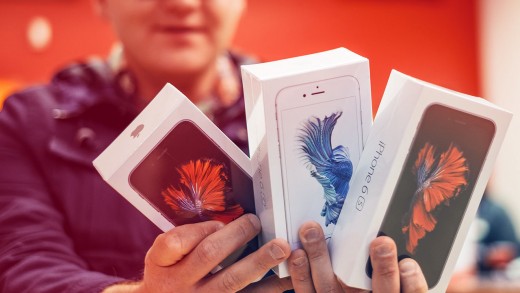What To Expect From Apple’s Earnings Report Next Week
Many investors are nervous about reports that iPhone 6s sales are softening.
Apple is likely to report solid numbers for its December-ending quarter but company execs and investors may be anxious over possible weakness in sales of the iPhone when they report their earnings on Tuesday evening.
In fact, analysts believe that Apple will report the slowest growth in iPhone sales ever for the quarter, which contained the holiday shopping season.
But its the longer-term forests of iPhone sales that have investors worried. That’s what’s been deflating the price of Apple’s stock in recent weeks. Shares that opened 2016 trading at $105.35 were selling for $99.44 at the close of the market on Monday, January 25, after dipping even lower last week.
Sales of the iPhone typically contribute roughly two-thirds of Apple’s revenue.
The Short View
Since late in 2015, reports from iPhone parts suppliers suggest that we’re just at the top edge of what could be a significant slowdown in iPhone sales.
A January 6 news story in the Asian business journal Nikkei said Asian suppliers are expecting Apple to “reduce output of its latest iPhone models by 30% in the January-March quarter compared with its original plans.” The report says Apple originally told suppliers to maintain the normal seasonal parts production levels of earlier phones.
A Fast Company source close to the U.S. suppliers said Apple has indeed cut back its component orders starting in December.
As word that more suppliers were guiding parts sales lower for near-future periods, Apple analysts began revising their phone sales and earnings estimates for the current and next quarter.
Investment firm Piper Jaffray’s long-time Apple analyst Gene Munster was one of them. “We are lowering our March [quarter] iPhone estimates to 55 million from 62.5 million and June from 48.5 million to 45 million due to the collection of negative data points from Apple suppliers regarding March quarter estimates and our own supply chain checks,” he wrote in a recent investor note.
Munster expects to hear Apple report 75 million to 76 million phones for the quarter, a 2% bump over the same quarter last year.
A survey of analysts by Thompson Reuters predicts Apple will announce a mere 1.3% sales growth for the quarter, which Reuters says would represent the slowest growth in iPhone sales since Apple began making the devices back in 2007.
Yahoo analyst consensus expects Apple to report $76.67 billion in revenue for the quarter, compared with the $74.60 billion it reported in last year’s December-ending quarter. The analysts expect Apple to report $56.1 billion in revenues for the March quarter, compared with the $58.01 billion it reported in the year-ago quarter (down 3.3%).
The Long View
But there’s a more general theme at play here, too. Apple’s stock began moving downward well before the troubling reports from the supply chain began filtering through. Apple shares sold for as much as $134.54 last April, before closing the year at around $105.
Apple is now suffering from its own success, or more precisely, the success of its iPhone 6, introduced in 2014.
iPhone Quarterly Sales and Price | SpecOut
The iPhone 6 and 6 Plus were a radical departure from earlier iPhones—their screens were much bigger (4.7 inches and 5.5 inches, respectively). They were the answer to many, many Apple devotees’ desire for a larger phone, and they sold monstrously. That’s a very hard act to follow for Apple’s 2015 releases, the iPhone 6s and iPhone 6s Plus, which are almost exactly the same size and shape their predecessors (the 6s and 6s Plus are slightly thicker).
The 6s and 6s Plus offer some significant component and feature upgrades: an improved 12 megapixel camera, an impressive A9 chip, and 3D Touch, a new way to press down on the screen to call up contextual menus.
But those feature upgrades might not be enough. Reports have noted that many iPhone buyers are likely eschewing the 6s for a new iPhone 6, which many consumers believe offer almost as much value, but at reduced prices. Meanwhile, reports have noted that iPhone 6s and 6s Plus inventory is backing up at Apple Stores.
The Bright Side
But Apple investors have reason to be optimistic. People around the world love iPhones; that won’t change any time soon. During Apple’s last quarterly report back in October, CEO Tim Cook had some very good reasons to feel bullish about iPhone sales. He cited record numbers of people switching from Android phones to iPhones, and pointed out that only about 30% of the user base has upgraded to one of the newest iPhones. He added that iPhone penetration rates are still low in huge, emerging markets like China and India, which means lots of opportunity for new sales.
Further, Munster says the investors he’s talked to are not that concerned about soft iPhone sales numbers in the next two quarters. They are concerned about the consumer appeal of the next iPhone—probably called the iPhone 7—which will likely be announced in September.
And, there’s increasing evidence that Apple is working on a smaller and cheaper iPhone, possibly called the iPhone 6c, aimed new markets like China and India. Some believe that this new phone will debut in March.
If this happens, the whole calculation changes, and investors might suddenly begin feeling much better about Apple’s stock.
The History Of Apple (In Three Minutes)
Fast Company , Read Full Story
(33)














